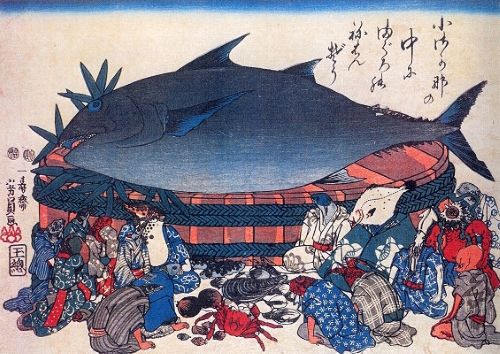
After the Kamakura period, it was said that “the sound of the voice calling “shibi” sounds like the day of death, which is ominous,” and when power was passed to the samurai, the word “shibi” became associated with “day of death,” and if a tuna lost its life in battle, it was avoided by the samurai as a good luck charm.
Tuna was mainly caught off the coast of Choshi, and was transported to Edo by boat, then placed on a cart and transported through the city of Edo, hidden by straw mats and covered with water. Tuna is large, and the fact that they looked exactly like Dozaemon, who had been drowned, was one of the reasons they were disliked. The fat in particular spoiled quickly, falling apart, and had a strong odor.
At this time there was no ice, so tuna had to be salted. It was cut into blocks, salt was spread all over and in it, and that was it. At Uogashi (the market before Tsukiji), it was treated at shops that specialized in salting fish. The dark, discolored, salty chunks of flesh really were nothing but “Gezakana”.
Gezakana -Relatively low-cost sushi ingredients, such as gizzard shad and horse mackerel. Bluefin tuna used to be also called gezakana in the Edo period, for losing its freshness easily.
This is why they were treated as a lower-class fish, but something changed around 1804-1818. At that time, soy sauce was widely used in the Kanto region, especially in Choshi, so a preservation technique was devised in which fillets of tuna were marinated in salty soy sauce and delivered safely while still raw. Needless to say, this is what we call today’s Zuke. This encounter with soy sauce helped to popularize tuna in the Edo period.
Tuna is originally caught in the open sea. However, due to some tidal current or abnormal weather, an incident occurred where large numbers of tuna were caught in nearby waters. This happened in 1832. It is said that as many as 10,000 were caught in one day. Because so many were caught, it spread, and Edo city was overflowing with tuna. Fresher tuna began arriving in Edo than before.
Around 1810, a new type of sushi was invented in Edo by Hanaya Yohei, in which fish fillets were sold on vinegared rice. Unlike traditional sushi that is fermented (such as narezushi), Kohei’s sushi is made by placing fish meat marinated in soy sauce on top of vinegared rice.
This fast-serving style marked the birth of modern edomae sushi and helped elevate tuna from gezakana to a prized topping in Japanese cuisine.
Related contents: TYPES OF TUNA
We hope this information will be helpful.

Revision date: June 17, 2025
Share this article